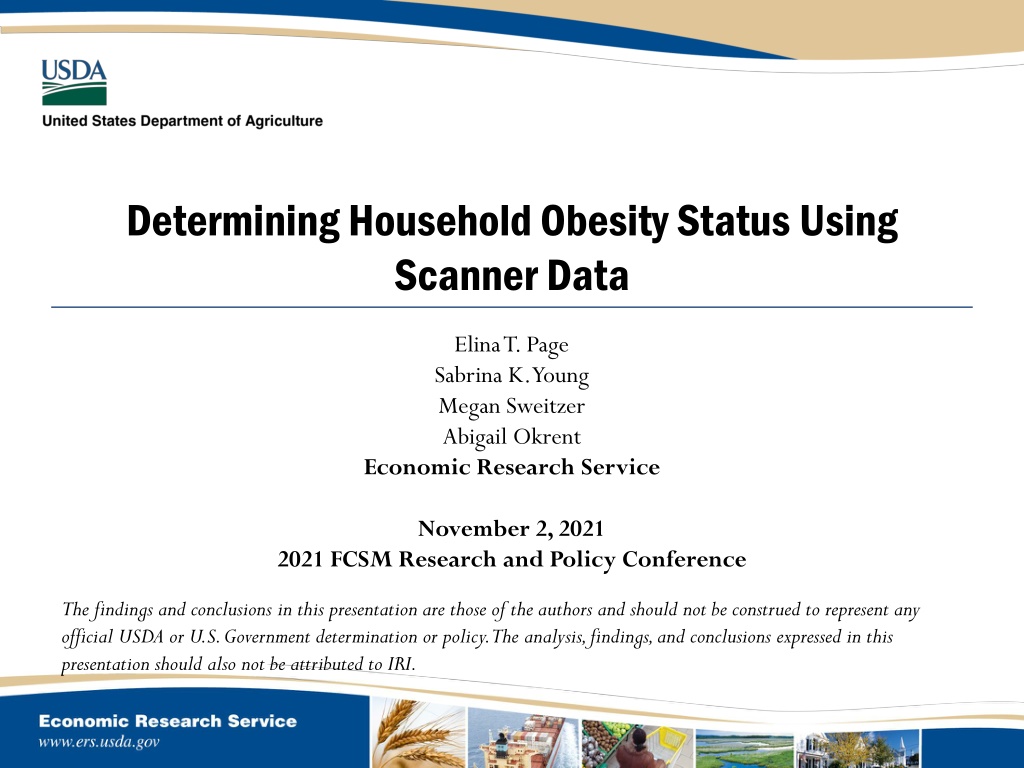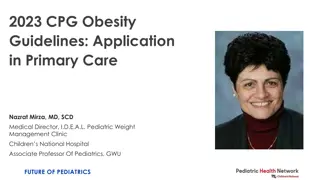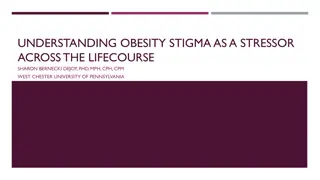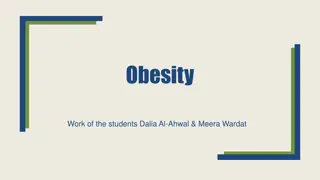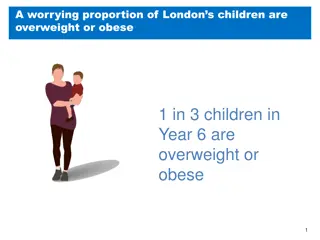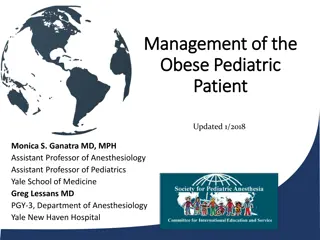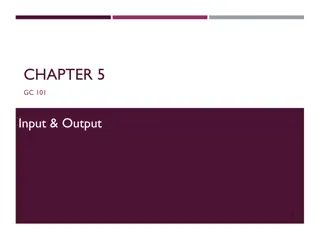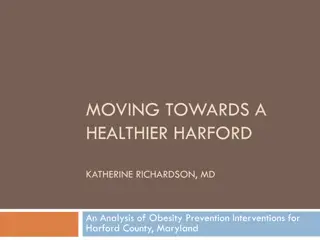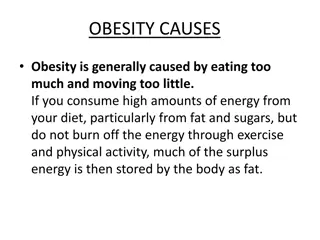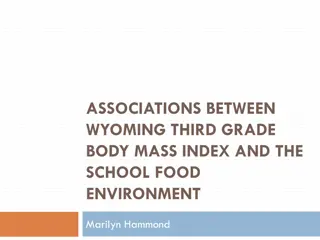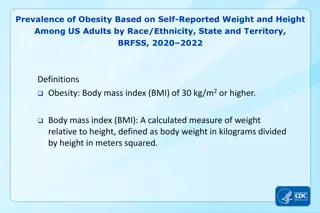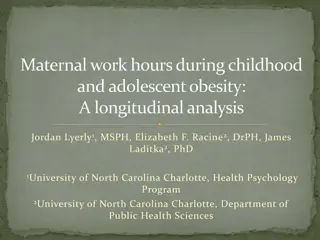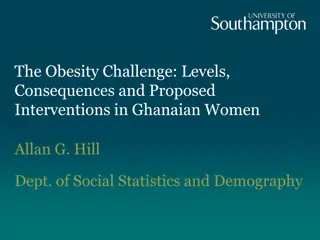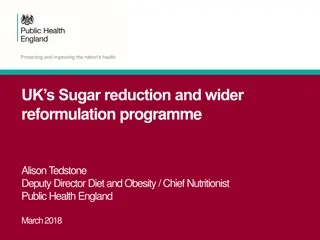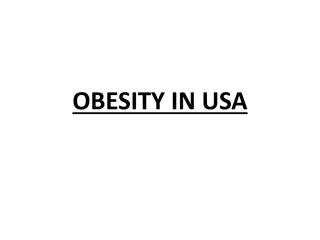Determining Household Obesity Status Using Scanner Data
Utilizing scanner data and household demographics to assess obesity status, this study investigates the impact of diet on health, particularly in the United States. The research aims to validate BMI distributions and adjust for biases in self-reported data.
Download Presentation

Please find below an Image/Link to download the presentation.
The content on the website is provided AS IS for your information and personal use only. It may not be sold, licensed, or shared on other websites without obtaining consent from the author.If you encounter any issues during the download, it is possible that the publisher has removed the file from their server.
You are allowed to download the files provided on this website for personal or commercial use, subject to the condition that they are used lawfully. All files are the property of their respective owners.
The content on the website is provided AS IS for your information and personal use only. It may not be sold, licensed, or shared on other websites without obtaining consent from the author.
E N D
Presentation Transcript
Determining Household Obesity Status Using Scanner Data Elina T. Page Sabrina K. Young Megan Sweitzer Abigail Okrent Economic Research Service November 2, 2021 2021 FCSM Research and Policy Conference The findings and conclusions in this presentation are those of the authors and should not be construed to represent any official USDA or U.S. Government determination or policy. The analysis, findings, and conclusions expressed in this presentation should also not be attributed to IRI.
Diet is the Primary Contributor to Poor Health in the US Diet is the Primary Contributor to Poor Health in the US Source: US Burden of Disease Collaborators. The State of US Health, 1990-2016: Burden of Diseases, Injuries, and Risk Factors Among US States.JAMA 2018. 2
Obesity in the United States Current rate of obesity: 40% of adults Obesity linked to increased risk of morbidity and mortality. Economic burden of disease: $1.7 trillion $480.7 billion in direct expenditures $1.24 trillion in lost productivity 21% of youth Sources: Ogden et al. (2020) Waters and Graf (2018) 3
Scanner Data Household Scanner Data: IRI Consumer Network Itemized food purchase data for 120,000 households Household demographics and survey weights IRI Medprofiler Opt-in survey on health and medical conditions Includes self-reported height and weight 4
Issue and Research Objective Issue: Medprofiler height and weight are self-reported and may be biased. Objective: Validate Medprofiler BMI distributions by comparing to self-reported and measured BMI distributions from NHANES and test methods of adjustment. 5
Methods of Adjustment Remove outliers: based on interquartile range based on range of values reported in NHANES Correct misreporting using self-reported and measured BMI in NHANES and percentile ranking regressions. Percentile rank self-reported NHANES BMI Regress measured weight on cubic splines of the percentile ranks Apply estimated coefficients to self-reported Medprofiler BMI Source: Courtemanche et al. (2015) 6
Composition of NHANES and IRI MedProfiler Samples Ages 20+ NHANES 20,409 14 66 11 06 03 49 MedProfiler 320,682 13 70 11 04 02 45 Sample size Hispanic (%) Non-Hispanic White (%) Non-Hispanic Black (%) Non-Hispanic Asian (%) Other (%) Male (%) Actual measurements Mean BMI (kg/m2) Proportion underweight (%) Proportion normal weight (%) Proportion overweight (%) Proportion obese (%) Self-reported measurements Mean BMI (kg/m2) Proportion underweight (%) Proportion normal weight (%) Proportion overweight (%) Proportion obese (%) 29.23 02 27 32 39 -- -- -- -- -- 28.49 02 31 34 34 28.86 02 30 33 35 7
Self-Reported (MedProfiler) and Measured (NHANES) BMI for Adults (20+) Hispanic Non-Hispanic Asian .1 .1 Density Density .05 .05 0 0 0 50 100 150 0 50 100 150 BMI (kg/m^2) BMI (kg/m^2) Non-Hispanic White Non-Hispanic Black .1 .1 Density Density .05 .05 0 0 0 50 100 150 0 50 100 150 BMI (kg/m^2) BMI (kg/m^2) MedProfiler Female Measured NHANES Female MedProfiler Male Measured NHANES Male 8
Hispanic .08 .06 Density .04 .02 0 0 20 40 60 80 100 BMI (kg/m^2) MedProfiler Female MedProfiler Male Measured NHANES Female Measured NHANES Male 9
Non-Hispanic White .08 .06 Density .04 .02 0 0 50 100 150 BMI (kg/m^2) MedProfiler Female MedProfiler Male Measured NHANES Female Measured NHANES Male 10
Non-Hispanic Black .08 .06 Density .04 .02 0 0 50 100 150 BMI (kg/m^2) MedProfiler Female MedProfiler Male Measured NHANES Female Measured NHANES Male 11
Non-Hispanic Asian .1 Density .05 0 0 20 40 60 80 100 BMI (kg/m^2) MedProfiler Female MedProfiler Male Measured NHANES Female Measured NHANES Male 12
Results: A Comparison of Methods Adult (Age 20+) 100% 90% 0.33 0.34 0.35 0.35 0.39 0.39 80% 70% 60% 50% 0.34 0.34 0.33 0.33 0.32 0.32 40% 30% 20% 0.31 0.31 0.30 0.30 0.27 0.28 10% 0.02 0.02 0.02 0.02 0.02 0.01 0% NHANES Measured NHANES Self- Reported MedProfiler (All) MedProfiler (NHANES Outliers Excluded) MedProfiler (IQR Outliers Excluded) MedProfiler (Percentile Ranking Regressions) Underweight Normal Weight Overweight Obese 13
Results: A Comparison of Methods Mean BMI (kg/m2) Underweight (%) Normal weight (%) Overweight (%) Obese (%) NHANES (Measured) 29.23 02 27 32 39 NHANES (Self-Reported) 28.49 02 31 34 34 MedProfiler (Unadjusted) 28.86 02 30 33 35 MedProfiler (NHANES Outliers Excluded) MedProfiler (IQR Outliers Excluded) MedProfiler (Percentile Ranking Regressions) 28.81 02 30 33 35 28.18 02 31 34 33 29.26 01 28 32 39 14
Predicted BMI Using Percentile Ranking Regressions: Hispanic Adults 15
Predicted BMI Using Percentile Ranking Regressions: Non-Hispanic White Adults 16
Predicted BMI Using Percentile Ranking Regressions: Non-Hispanic Black Adults 17
Predicted BMI Using Percentile Ranking Regressions: Non-Hispanic Asian Adults 18
Next Steps Finalize guidance for researchers: For adjusting BMI. For defining household obesity. Analyze household food purchases by household obesity status. 19
Thank you! elina.t.page@usda.gov 20
